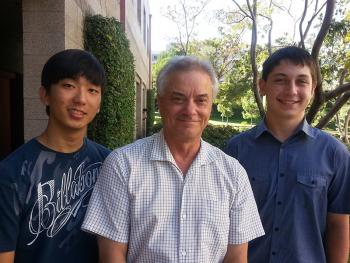Mentoring High School Students in Game Software Engineering
At ISR, we regularly engage graduate students, postdoctoral students, and sometimes undergraduate students to work as research assistants directed by ISR faculty. We have not previously worked with or mentored high school students in ISR research projects, so this is something new – in this case, taken on by Prof. Walt Scacchi. In Spring 2014, Scacchi was approached independently by two students from Northwood High School in Irvine who were seeking a summer research project to work on while being mentored. It turned out that the two students, Ryan Lim and Mark Yampolsky, didn’t know each other, but Scacchi decided that a two student effort made sense as an interesting challenge for a student research team that he could mentor and direct.
 Lim and Yampolsky are new to computer science and software engineering research, but they considered themselves skilled computer game players who are also accomplished students in their high school science, technology, engineering, and math (STEM) coursework. As Scacchi was already completing a new book with colleague Kendra Cooper at the University of Texas, Dallas titled “Computer Games and Software Engineering” (CRC Press, to appear 2015), he invited Lim and Yampolsky to meet with him to discuss a research problem he felt would be appropriate to their interests and skill level. Specifically, he gave them the task of playing and systematically comparing a sample of two dozen computer games. Computer game “playtesting” addresses problems in non-functional requirements validation, software testing, and software usability (user experience). Large commercial game development companies such as Microsoft Studios employ dozens of researchers to conduct empirical studies that playtest new games or games in development, with hundreds to thousands of game players. Game playtesting is a new problem area that has arisen at the intersection of computer games and software engineering.
Lim and Yampolsky are new to computer science and software engineering research, but they considered themselves skilled computer game players who are also accomplished students in their high school science, technology, engineering, and math (STEM) coursework. As Scacchi was already completing a new book with colleague Kendra Cooper at the University of Texas, Dallas titled “Computer Games and Software Engineering” (CRC Press, to appear 2015), he invited Lim and Yampolsky to meet with him to discuss a research problem he felt would be appropriate to their interests and skill level. Specifically, he gave them the task of playing and systematically comparing a sample of two dozen computer games. Computer game “playtesting” addresses problems in non-functional requirements validation, software testing, and software usability (user experience). Large commercial game development companies such as Microsoft Studios employ dozens of researchers to conduct empirical studies that playtest new games or games in development, with hundreds to thousands of game players. Game playtesting is a new problem area that has arisen at the intersection of computer games and software engineering.
The games selected for the study were focused on either informal science education or on engaging “citizen scientists.” Scacchi refers to this genre of computer games as science learning games – games that help players learn and do science. Citizen science game play results, in particular, contribute to the solution of authentic scientific research problems, such as identifying the structure and folds of complex proteins. The games vary in the scientific domain knowledge required to master play, ranging from 5th grade science basics through undergraduate level scientific expertise. After explaining their task, Scacchi suggested a summer-long (10+ week) study duration that would culminate in the documentation and publication of their findings. The project was a success, with Lim and Yampolsky successfully completing their respective sub-tasks, as well as the overall final report.
The report is publicly available on the ISR website as an ISR technical report. The report, “Making Learning Fun: An Analysis of Game Design in Science Learning Games,” is 74 pages in length. It includes a description and link to a new HTML5-based game developed by Yampolsky called Beam, which implements simple, multi-level play mechanics for solving basic problems in optical beam pathway design, which are fundamental to emerging problems in photonics research and quantum teleportation studies.
Lim and Yampolsky were each personally responsible for playtesting, assessing, and documenting 13 games (out of 26 in the final sample), and for compiling and completing the final report. Yampolsky went on to also try out and apply his new knowledge in game development, the result of which is also documented in the final report. Admittedly, Scacchi provided the outline of the report, and contributed to the framing, introduction, and final report section, as well as some light editing of the report and discussion of research problems in photonics and quantum teleportation that might be amenable for demonstration in a computer game. But overall, Scacchi’s time on the report was modest compared to Lim’s and Yampolsky’s.
Lim and Yampolsky elected to continue to work with Scacchi in the Fall and beyond on this project, as well as some extensions to the Beam game and a new game being developed by Lim. Scacchi believes it possible to develop one or more separate research papers suitable for publication in a computer game conference or research journal in the months ahead, which is something both Lim and Yampolsky are eager to do before they graduate from high school in Spring 2015. Lim and Yampolsky are applying for college admission for Fall 2015 to top CS programs at Carnegie Mellon, Columbia, Stanford, Yale, UCI, and elsewhere, having completed and published the results of their first software research project.



